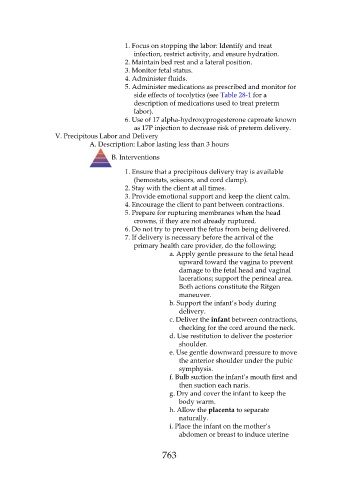Page 763 - Saunders Comprehensive Review For NCLEX-RN
P. 763
1. Focus on stopping the labor: Identify and treat
infection, restrict activity, and ensure hydration.
2. Maintain bed rest and a lateral position.
3. Monitor fetal status.
4. Administer fluids.
5. Administer medications as prescribed and monitor for
side effects of tocolytics (see Table 28-1 for a
description of medications used to treat preterm
labor).
6. Use of 17 alpha-hydroxyprogesterone caproate known
as 17P injection to decrease risk of preterm delivery.
V. Precipitous Labor and Delivery
A. Description: Labor lasting less than 3 hours
B. Interventions
1. Ensure that a precipitous delivery tray is available
(hemostats, scissors, and cord clamp).
2. Stay with the client at all times.
3. Provide emotional support and keep the client calm.
4. Encourage the client to pant between contractions.
5. Prepare for rupturing membranes when the head
crowns, if they are not already ruptured.
6. Do not try to prevent the fetus from being delivered.
7. If delivery is necessary before the arrival of the
primary health care provider, do the following:
a. Apply gentle pressure to the fetal head
upward toward the vagina to prevent
damage to the fetal head and vaginal
lacerations; support the perineal area.
Both actions constitute the Ritgen
maneuver.
b. Support the infant’s body during
delivery.
c. Deliver the infant between contractions,
checking for the cord around the neck.
d. Use restitution to deliver the posterior
shoulder.
e. Use gentle downward pressure to move
the anterior shoulder under the pubic
symphysis.
f. Bulb suction the infant’s mouth first and
then suction each naris.
g. Dry and cover the infant to keep the
body warm.
h. Allow the placenta to separate
naturally.
i. Place the infant on the mother’s
abdomen or breast to induce uterine
763

